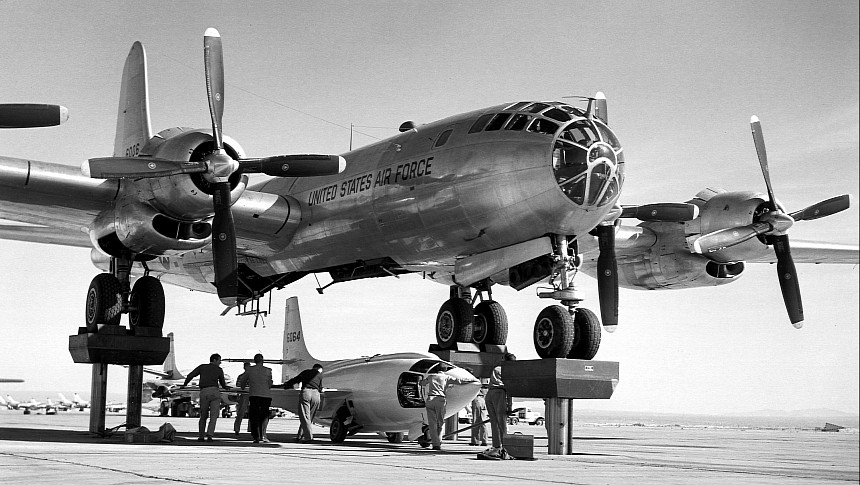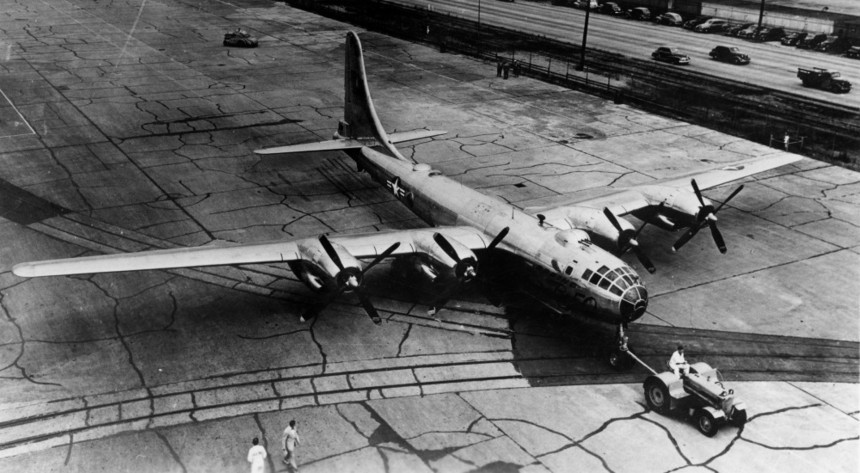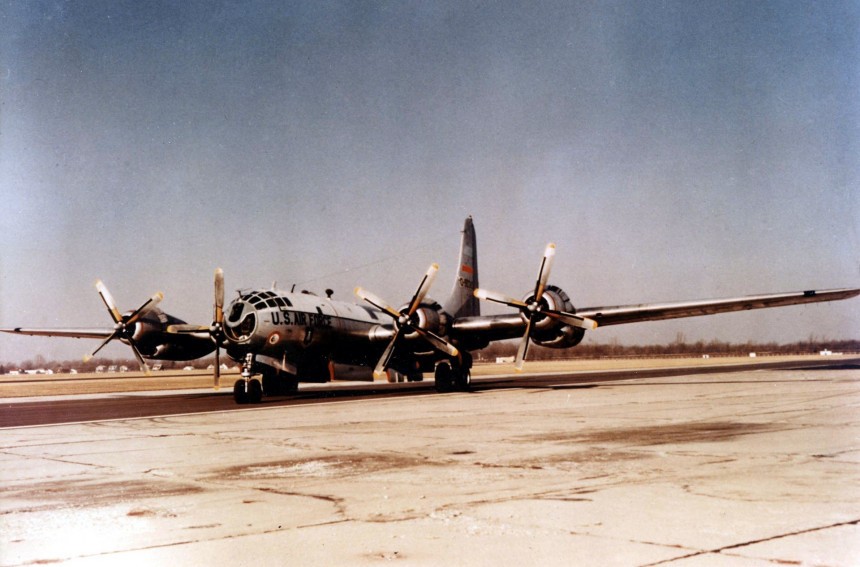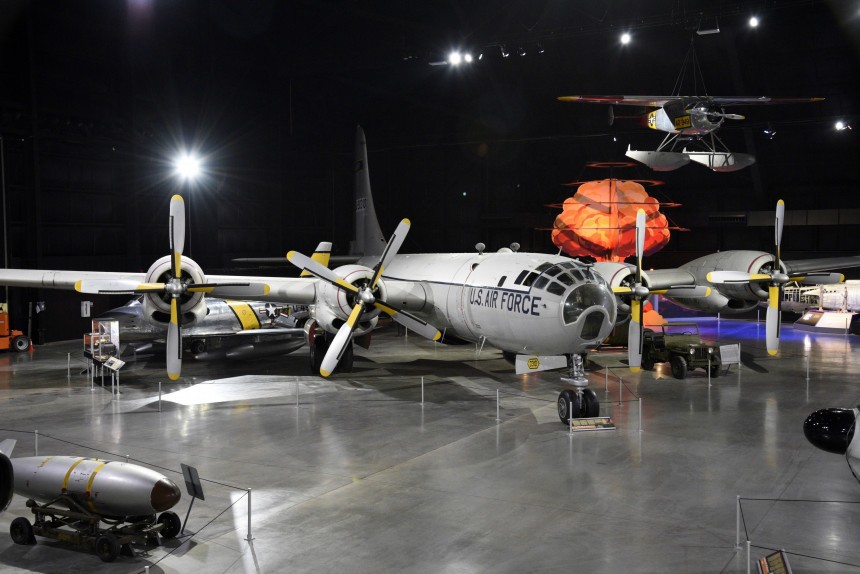Every once in a while, the U.S. Air Force lets out their inner petrolhead. During the tail end of World War II and the Cold War especially, taking an existing airframe and fitting more powerful engines was more viable than designing a new aircraft from scratch. It was to the point where even World War II's most famous bomber was given this treatment. This is the story of the Boeing B-50 Superfortress, the iconic B-29 given the full hot rod treatment.
Let's try and paint the scene for you. The year is 1947, the Axis forces have capitulated, and the Eastern and Western sides of the victorious Allied nations are busying themselves carving up Europe along arbitrary and hastily thought-out lines that'll shape the continent for the next half-century. Oh, and the world's Air Forces have simultaneously ditched piston-engined warplanes in favor of jet power. That'll become very important later. Fresh off the sole two atomic weapon deployments over Imperial Japan, the Boeing B-29 cemented itself as a fixture in world history and as America's premiere heavy strategic bomber.
But to understand where the Superfortress eventually wound up after the war, we must remember that its development was a hellish experience. Av-geeks tend to forget just how much of a pain in the you-know-what the B-29 Superfortress was to put into production. From its Curtiss-Wright R-3350 Duplex Cyclone 18-cylinder engines with a penchant for spontaneous combustion to its analog computer-driven gun turrets that sometimes went on the fritz, there was no shortage of engineering headaches for Boeing during the B-29's labored development process.
For this reason, the B-29 was something of an F-35 figure of its day. One notorious for the ludicrous level of tax-payer money that went into its deployment and for being an albatross around the neck of U.S. Air Force. The Superfortress was the most expensive Allied project of the entire war by a country mile. And yes, that includes the Manhattan Project. Hardly a single Superfortress test flight went off without a hitch in its early days. A few even crashed with fatal consequences due to mechanical issues that hadn't yet been solved. But by the end of the war and the atomic bombings of Japan by special "Silverplate" B-29s, most of the nasty mechanical snafus were worked out. B-29s would then go on to serve with the USAF in various capacities until 1960.
But even before the end of the war, Boeing's engineers reckoned the full extent of the B-29's capabilities had yet to be reached. The Superfortress could be an even more potent airframe with a suitable set of upgrades, or so they thought. The drive towards building a better, faster, more capable B-29 started just as the planning for the D-Day invasions was wrapping up in 1944. The first attempt at replacing the often-problematic Duplex Cyclone engines came in the form of the gargantuan Allison V-3420 W-24 engine. At 3,420 cubic inches of displacement (56 L) and two massive banks of 12 cylinders each, its maximum power output of 2,600 hp was a nice improvement over the R-3350's 2,200 hp figure, even more so with turbosuperchargers installed.
A single B-29 was modified with these engines and dubbed the Boeing XB-39, but the US Army Air Corps passed over the design in favor of pushing more standard B-29s into service. The XB-39 was more of a technology demonstrator to prove the Superfortress could adapt to accept different engines rather than an attempt to upgrade the plane overall. To do this job, Boeing needed an even more bonkers powerplant. Luckily, Pratt & Whiney of East Hartford, Connecticut, had just the thing to scratch Boeing's itch. To put it in automotive terms, the Wright R-3350 was like a Chevy 350 small block V8, and the Pratt & Whitney R-4360 Wasp Major was the big block 454.
With a scarcely believable 71.5 liters of displacement, a massive turbosupercharger, and a dry weight that rivals a modern full-sized American sedan, is it any wonder the Wasp Major cranked 4,300 hp? The R-4360 was so powerful that the force of its residual exhaust gasses accounted for 320 lbs of jet thrust, or around 200 hp extra. With four of these leviathans under its wings, what was initially called the XB-44 could be a force to be reckoned with even into the jet age. With dimensions equal to the B-29 in length and wingspan, the most notable changes besides the new engines were found in its vertical control surfaces.
Both the rear rudder and the vertical stabilizer were considerably larger on the XB-44, to the point where its overall height was roughly a meter and a half (4.9 ft) taller than what preceded it. Though the blueprints for the XB-44, or B-29D as it was called in some circles, were set before the end of World War II, Japan's total capitulation by September 1945 prevented it from seeing combat during the conflict. Even so, a single B-29 was converted into the world's only XB-44, which first took flight on June 25, 1947. It was clear from the moment the newly-christened B-50 lifted tires off the tarmac that the endless headaches from the B-29 had paid off in spades.
The novel 75-S-grade aluminum alloy used in its construction was considerably lighter and stronger than the 24ST-grade used with the B-29. Meaning not only was the B-50 37 mph (59.5 kph) faster than the B-29 at the top end, but it could also carry 40,000 lbs (18,000 kg) more payload. Some later modified variants could even carry a single 43,600 lb (19,800 kg) T-12 Cloud Maker earthquake bomb. All the while, re-worked engine cooling hardware ensured the same fires that plagued the B-29 were few and far between. Add in 13 computer-guided M2 Browning .50 caliber defensive machine guns and even North Korean MiG-15 pilots were weary of strafing the B-50's well-protected hindquarters.
Should the need have risen, the B-50 could have easily deployed nuclear weapons over Soviet territory. Using novel British-developed aerial refueling hardware, B-50s had the range to drop such devastating ordinance and make the trip back to the continental U.S. in a single flight. Over time, Boeing improved the refueling system, implementing the all-familiar, boom-operated system with the B-50D variant. Instead, its first deployment in the skies over North Korea saw it dropping conventional munitions over the war-torn battlefields of the 38th Parallel.
Indeed, the B-50 was well suited to old-fashioned carpet bombing tactics that mimicked the daylight bombing campaigns of Europe and the Pacific less than a decade prior. But against secret Soviet pilots in their equally Soviet MiG-15 jet fighters, B-50 pilots had all the hell they could handle during their bomb runs. A common tactic in the day was to calibrate the B-50's defensive M2 Brownings to focus all their fire on a single target in the hope that enemy jets would fly into a proverbial wall of American lead. This tactic had mixed results in the field.
With its tremendous payload capacity, the B-50 was just as suited for more specialized missions like photoreconnaissance, weather monitoring, and aerial refueling as it was as a bomber. A few were even fitted with one 2 × General Electric J47-GE-23 turbojet engine under each wing for added grunt when the specialized WB-50Js flew through in close proximity to hurricanes with the USAF's Tactical Air Command (TAC). Granted, a fair few accidents occurred during WB-50 weather mapping missions, accounting for the loss of 66 crew members.
To cap off a checkered service history, B-50s were instrumental in the testing of the Bell X-1, the rocket plane Chuck Yeager used to become the first human to break the sound barrier and live to tell the tale. The last WB-50s were retired by 1965, citing metal fatigue and the onset of better, faster jet and turboprop-powered aircraft.
Today, only five of the 370 B-50 airframes produced survive. Including one at the National Museum of the United States Air Force in Dayton, Ohio, a place we're all too familiar with around here.
But to understand where the Superfortress eventually wound up after the war, we must remember that its development was a hellish experience. Av-geeks tend to forget just how much of a pain in the you-know-what the B-29 Superfortress was to put into production. From its Curtiss-Wright R-3350 Duplex Cyclone 18-cylinder engines with a penchant for spontaneous combustion to its analog computer-driven gun turrets that sometimes went on the fritz, there was no shortage of engineering headaches for Boeing during the B-29's labored development process.
For this reason, the B-29 was something of an F-35 figure of its day. One notorious for the ludicrous level of tax-payer money that went into its deployment and for being an albatross around the neck of U.S. Air Force. The Superfortress was the most expensive Allied project of the entire war by a country mile. And yes, that includes the Manhattan Project. Hardly a single Superfortress test flight went off without a hitch in its early days. A few even crashed with fatal consequences due to mechanical issues that hadn't yet been solved. But by the end of the war and the atomic bombings of Japan by special "Silverplate" B-29s, most of the nasty mechanical snafus were worked out. B-29s would then go on to serve with the USAF in various capacities until 1960.
But even before the end of the war, Boeing's engineers reckoned the full extent of the B-29's capabilities had yet to be reached. The Superfortress could be an even more potent airframe with a suitable set of upgrades, or so they thought. The drive towards building a better, faster, more capable B-29 started just as the planning for the D-Day invasions was wrapping up in 1944. The first attempt at replacing the often-problematic Duplex Cyclone engines came in the form of the gargantuan Allison V-3420 W-24 engine. At 3,420 cubic inches of displacement (56 L) and two massive banks of 12 cylinders each, its maximum power output of 2,600 hp was a nice improvement over the R-3350's 2,200 hp figure, even more so with turbosuperchargers installed.
With a scarcely believable 71.5 liters of displacement, a massive turbosupercharger, and a dry weight that rivals a modern full-sized American sedan, is it any wonder the Wasp Major cranked 4,300 hp? The R-4360 was so powerful that the force of its residual exhaust gasses accounted for 320 lbs of jet thrust, or around 200 hp extra. With four of these leviathans under its wings, what was initially called the XB-44 could be a force to be reckoned with even into the jet age. With dimensions equal to the B-29 in length and wingspan, the most notable changes besides the new engines were found in its vertical control surfaces.
Both the rear rudder and the vertical stabilizer were considerably larger on the XB-44, to the point where its overall height was roughly a meter and a half (4.9 ft) taller than what preceded it. Though the blueprints for the XB-44, or B-29D as it was called in some circles, were set before the end of World War II, Japan's total capitulation by September 1945 prevented it from seeing combat during the conflict. Even so, a single B-29 was converted into the world's only XB-44, which first took flight on June 25, 1947. It was clear from the moment the newly-christened B-50 lifted tires off the tarmac that the endless headaches from the B-29 had paid off in spades.
The novel 75-S-grade aluminum alloy used in its construction was considerably lighter and stronger than the 24ST-grade used with the B-29. Meaning not only was the B-50 37 mph (59.5 kph) faster than the B-29 at the top end, but it could also carry 40,000 lbs (18,000 kg) more payload. Some later modified variants could even carry a single 43,600 lb (19,800 kg) T-12 Cloud Maker earthquake bomb. All the while, re-worked engine cooling hardware ensured the same fires that plagued the B-29 were few and far between. Add in 13 computer-guided M2 Browning .50 caliber defensive machine guns and even North Korean MiG-15 pilots were weary of strafing the B-50's well-protected hindquarters.
Indeed, the B-50 was well suited to old-fashioned carpet bombing tactics that mimicked the daylight bombing campaigns of Europe and the Pacific less than a decade prior. But against secret Soviet pilots in their equally Soviet MiG-15 jet fighters, B-50 pilots had all the hell they could handle during their bomb runs. A common tactic in the day was to calibrate the B-50's defensive M2 Brownings to focus all their fire on a single target in the hope that enemy jets would fly into a proverbial wall of American lead. This tactic had mixed results in the field.
With its tremendous payload capacity, the B-50 was just as suited for more specialized missions like photoreconnaissance, weather monitoring, and aerial refueling as it was as a bomber. A few were even fitted with one 2 × General Electric J47-GE-23 turbojet engine under each wing for added grunt when the specialized WB-50Js flew through in close proximity to hurricanes with the USAF's Tactical Air Command (TAC). Granted, a fair few accidents occurred during WB-50 weather mapping missions, accounting for the loss of 66 crew members.
To cap off a checkered service history, B-50s were instrumental in the testing of the Bell X-1, the rocket plane Chuck Yeager used to become the first human to break the sound barrier and live to tell the tale. The last WB-50s were retired by 1965, citing metal fatigue and the onset of better, faster jet and turboprop-powered aircraft.














